
It’s May in Indiana – and we know what that means – it’s race time! As things are heating up at the Indianapolis 500 Motor Speedway, we know that farm fields are abuzz with tractors and implements planting the 2023 crop.
It's race time for Indiana agriculture as farmers across this state try to beat Mother Nature’s spring rains and unpredictable weather conditions. While farmers are racing to get crops in the ground, our FSA county offices will be at the finish line waiting for you to certify your crops later this spring. We stand ready to answer your questions and to be your pit stop for all the programs that you can take advantage of on your farming operation.
We wish you a safe planting season and look forward to seeing you soon in the county office.
All my best,
|
 State Executive Director

The nomination period for the USDA Farm Service Agency’s annual county committee election begins June 15 and continues through August 1, 2023. We will spotlight one of Indiana's FSA County Committee members in our newsletters during the next few months.
Meet Jennifer Clouse Swope of Bartholomew County.
Generations Farming Together
Jennifer is the sixth generation to work on the family farm and it is especially important to her that the farm continues for many years to come. Jennifer felt that her upbringing on the farm was crucial in shaping her into who she is today. She never considered any other career.
Jennifer is part of a family owned and operated row crop operation, focusing on corn, soybeans and wheat with her parents and husband Will Swope. They also have a beef cow/calf operation. Jennifer and Will operate their own business selling seed and other biological products. They also operate an independent seed treatment facility where they treat soybeans and wheat for local growers.
Jennifer feels it is very rewarding and humbling to pour so much work into growing a crop and watching it grow. Every year brings along new sets of challenges; and she enjoys trying to maximize their production while working alongside her family.
Serving FSA and Bartholomew County Producers
Jennifer is a newly elected County Committee (COC) member, having begun her first term in January 2023.
Jennifer has grown up with the knowledge of the COC and the importance of connecting FSA programs with the local farmers. Both of her parents, Evan and Janet Clouse, have served on the Bartholomew County FSA County Committee.
Jennifer knows it is important to have checks and balances with programs and policy and it is beneficial to have a local influence in those checks and balances. She states, “The local input and perspective is important for the policies. Policy can seem daunting to producers but it is important to put faces to the policy so we can all work together to make the agricultural community great!”
Be a Voice
County committee members are farmers elected by their peers to serve as a direct link between the agricultural community and USDA. Farmers on the committee help deliver FSA farm programs at the local level and work to make FSA agricultural programs serve the needs of local producers.
Each year, FSA accepts nominations for a certain Local Administrative Area and the LAA up for election rotates each year.
Jennifer encourages farmers to get involved and run for County Committee. She said “Do it! It’s a great opportunity to gain knowledge about how policy impacts your farming operation and allows you to connect policy and programs for local farmers.’
More Information
For more information on FSA county committee elections, contact your local FSA office or visit fsa.usda.gov/elections.
|

The Inflation Reduction Act provides $2.2 billion in financial assistance for farmers, ranchers, and forest landowners who experienced discrimination in USDA’s farm lending programs prior to January 1, 2021.
USDA has become aware of some lawyers and groups spreading misleading information about this process, pressuring people to sign retainer agreements, and asking people to fill out forms with private and sensitive information.
Application forms for this program are not yet available and the application filing period has not started. Before the application process opens, USDA will publish a list of trusted community organizations located across the country that will provide FREE help completing applications.
Please beware of organizations seeking to file your application for a fee. Filing an application for the program will be FREE. You will not need a lawyer to file an application for this program. If you feel the need for legal advice, seek the assistance of a trusted, licensed attorney.
Beware of solicitations by mail, email, or phone calls from individuals claiming to be connected to USDA. USDA will not solicit you for information.
In this short video, Gloria Montano Greene, Deputy Under Secretary for USDA's Farm Production and Conservation, urges producers to avoid scams.
The most up-to-date information on this program will be posted at www.farmers.gov/22007, a USDA website. Please check there for any concerns or reach out to your local FSA office. To find your local office, visit farmers.gov/service-locator.
If you believe there is an organization conducting a scam related to this process, please contact the USDA Office of the Inspector General (OIG) or any other appropriate authorities. The USDA OIG hotline can be accessed online at https://usdaoig.oversight.gov/hotline and by phone at (800) 424-9121.
|
A multi-agency guide for USDA assistance for underserved farmers is now available. If you are a farmer and are a minority, woman, veteran, beginning, or limited resource producer, you can use this booklet to learn about assistance and targeted opportunities available to you. This includes programs offered through the Farm Service Agency, Natural Resources Conservation Service, and Risk Management Agency. Download the guide here. The guide is also available in Spanish, Hmong, Korean, Vietnamese, Thai and Chinese on farmers.gov/translations. |
|
 |

To be eligible for Phase Two, producers must have suffered a decrease in allowable gross revenue in 2020 or 2021 due to necessary expenses related to losses of eligible crops from a qualifying natural disaster event. Eligible crops include both traditional insurable commodities and specialty crops that are produced in the United States as part of a farming operation and are intended to be commercially marketed. This also includes losses of eligible on-farm stored commodities. ERP Phase 2 applicants will use the following tax years when selecting allowable gross revenue:
- Benchmark years: 2018 and/or 2019; estimated for new producers with no 2018 or 2019 revenue or adjusted if the benchmark years are not representative of the disaster year due to a change in operation size.
- Disaster years: 2020 and/or 2021. The allowable gross revenue for the specific disaster year will be based on the tax year applicable to that revenue (2020, 2021 or 2022).
The ERP tool assists producers in calculating allowable gross revenue, as well as adjusted revenue for the benchmark years 2018 and 2019, and allowable gross revenue for representative tax years 2020-2022 which represent disaster years 2020 and 2021. Once producers complete the allowable gross revenue entries, they are able to print forms FSA-521 and FSA-521A through this tool.
The ERP Phase 2 and PARP application period ends June 2, 2023.
For more information on payment calculations, payment limitations or how to determine allowable gross revenue, please reference the ERP Phase 2 fact sheet.
|
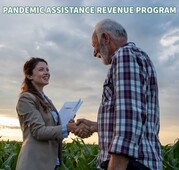
Pandemic Assistance Revenue
Program (PARP)
The Pandemic Assistance Revenue Program (PARP) assists eligible producers of agricultural commodities who experienced revenue decreases in calendar year 2020 compared to 2018 or 2019 due to the COVID-19 pandemic. PARP helps address gaps in previous pandemic assistance, which was targeted at price loss or lack of market access, rather than overall revenue losses.
Eligible and Ineligible Commodities
For PARP, eligible agricultural commodities include crops, aquaculture, livestock, livestock byproducts, or other animals or animal byproducts that are produced as part of a farming operation and are intended to be commercially marketed. This includes only commodities produced in the United States or those produced outside the United States by a producer located in the United States and marketed inside the United States.
The following commodities are not eligible for PARP:
- Wild free-roaming animals.
- Horses and other animals used or intended to be used for racing or wagering.
- Aquatic species that do not meet the definition of aquaculture.
-
Cannabis sativa L. and any part of that plant that does not meet the definition of hemp.
- Timber.
Program Eligibility
PARP payments will be made on a whole-farm basis, not commodity-by-commodity. To be eligible for PARP, an agricultural producer must have been in the business of farming during at least part of the 2020 calendar year and must have experienced a 15 percent decrease in allowable gross revenue in 2020, as compared to either:
- The 2018 or 2019 calendar year, as elected by the producer, if they received allowable gross revenue during the 2018 or 2019 calendar years, or
- The producer’s expected 2020 calendar year allowable gross revenue, if the producer had no allowable gross revenue in 2018 or 2019.
PARP payments will be issued after the application period ends on June 2, 2023.
For more information on determining allowable gross revenue visit farmers.gov/coronavirus/pandemic-assistance/parp or review the PARP fact sheet.
More Information
To apply for PARP, contact your local USDA Service Center.
|
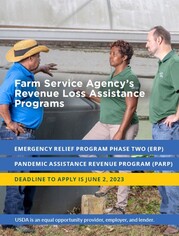
Myth-Busting FSA’s New Revenue-Based Disaster and Pandemic Assistance Programs
Both the Emergency Relief Program (ERP) Phase Two and the Pandemic Assistance Revenue Program (PARP) offer a holistic approach to disaster assistance and provide economic support for producers who bear the financial brunt of circumstances beyond their control.
With the rollout of any new program, there is a learning curve for producers and employees alike. ERP Phase Two and PARP are no exception. To encourage producer participation in these valuable programs, FSA is going to debunk some myths and misconceptions surrounding ERP Phase Two and PARP.
Myth #1 – You need to submit a completed tax return to FSA to apply for ERP Phase Two or PARP.
While these programs are based on revenue losses, you do not need a tax return, completed or otherwise, to apply for assistance. In fact, FSA has an ERP Phase 2 tool and PARP tool that walk you through the process step by step.
FSA understands that you may have questions for your certified public accountant or tax preparer, who was likely hard to reach prior to the April 18 Internal Revenue Service tax deadline however FSA encourages you to download the program decision tools and get started. You’ll probably discover that you already have on hand much of the information you need.
The following supporting materials will help you:
- Schedule F (Form 1040); and
-
Profit or Loss from Farming or similar tax documents for tax years 2018, 2019, 2020, 2021, and 2022 for ERP and for calendar years 2018, 2019, and 2020 for PARP.
The only reason you might have to provide your tax returns to FSA is in the event of a spot check or a request from the FSA County Committee.
Click here to read the full blog and view a producer testimonial
on the application process.
|
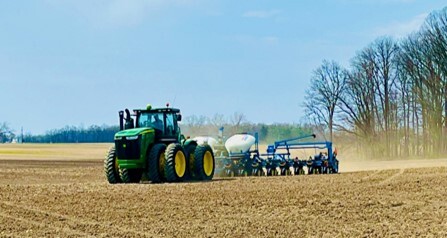
The USDA Farm Service Agency (FSA) acreage reporting policy for cover crops, revising intended use, late-filed provisions and grazing allotments.
Reporting Cover Crops:
Cover crop types can be chosen from the following four categories:
- Cereals and other grasses
- Legumes
- Brassicas and other broadleaves
- Mixtures
If the cover crop is harvested for any use other than forage or grazing and is not terminated according to policy guidelines, then that crop will no longer be considered a cover crop and the acreage report must be revised to reflect the actual crop.
Permitted Revision of Intended use After Acreage Reporting Date:
New operators or owners who pick up a farm after the acreage reporting deadline has passed and the crop has already been reported on the farm, have 30 calendar days from the date when the new operator or owner acquired the lease on land, control of the land or ownership and new producer crop share interest in the previously reported crop acreage. Under this policy, appropriate documentation must be provided to the County Committee’s satisfaction to determine that a legitimate operator or ownership and producer crop share interest change occurred to permit the revision.
Acreage Reports:
In order to maintain program eligibility and benefits, you must timely file acreage reports. Failure to file an acreage report by the crop acreage reporting deadline may result in ineligibility for future program benefits. FSA will not accept acreage reports provided more than a year after the acreage reporting deadline.
Reporting Grazing Allotments:
FSA offices can now accept acreage reports for grazing allotments. You will use form “FSA-578” to report grazing allotments as animal unit months (AUMs) using the “Reporting Unit” field. Your local FSA office will need the grazing period start and end date and the percent of public land.
Definitions of Terms
FSA defines “idle” as cropland or a balance of cropland within a Common Land Unit (CLU) (field/subfield) which is not planted or considered not planted and does not meet the definition of fallow or skip row.
Fallow is considered unplanted cropland acres which are part of a crop/fallow rotation where cultivated land that is normally planted is purposely kept out of production during a regular growing season.
Know Your Final Planting Dates
All producers are encouraged to contact their local FSA office for more information on the final planting date for specific crops. The final planting dates vary by crop, planting period and county so please contact your local FSA office for a list of county-specific planting deadlines. The timely planting of a crop, by the final planting date, may prevent loss of program benefits.
Producers are encouraged to schedule an appointment to file their acreage reports as soon as planting is completed.
For more information on acreage reporting, to receive a copy of your maps by email or to pick up a copy of your maps, contact your local USDA Service Center.
|

The Farm Service Agency (FSA) is accepting offers for specific conservation practices under the Conservation Reserve Program (CRP) Continuous Signup.
In exchange for a yearly rental payment, farmers enrolled in the program agree to remove environmentally sensitive land from agricultural production and to plant species that will improve environmental health and quality. The program’s long-term goal is to re-establish valuable land cover to improve water quality, prevent soil erosion, and reduce loss of wildlife habitat. Contracts for land enrolled in CRP are 10-15 years in length.
Under continuous CRP signup, environmentally sensitive land devoted to certain conservation practices can be enrolled in CRP at any time. Offers for continuous enrollment are not subject to competitive bidding during specific periods. Instead, they are automatically accepted provided the land and producer meet certain eligibility requirements and the enrollment levels do not exceed the statutory cap.
For more information, including a list of acceptable practices, contact your local USDA Service Center or visit fsa.usda.gov/crp.
|

If you intend to participate in the Agriculture Risk Coverage (ARC) or Price Loss Coverage (PLC) programs, you are subject to an acre-for-acre payment reduction when fruits and nuts, vegetables or wild rice are planted on payment acres of a farm. Payment reductions do not apply to mung beans, dry peas, lentils or chickpeas. Planting fruits, vegetables or wild rice on acres not considered payment acres will not result in a payment reduction. Farms that are eligible to participate in ARC/PLC but are not enrolled for a particular year may plant unlimited fruits, vegetables and wild rice for that year but will not receive ARC/PLC payments. Eligibility for succeeding years is not affected.
Planting and harvesting fruits, vegetables and wild rice on ARC/PLC acreage is subject to the acre-for-acre payment reduction when those crops are planted on more than 15 percent of the base acres of an ARC enrolled farm using the county coverage or PLC, or more than 35 percent of the base acres of an ARC enrolled farm using the individual coverage.
Fruits, vegetables and wild rice that are planted in a double-cropping practice will not cause a payment reduction if the farm is in a double-cropping region as designated by the USDA’s Commodity Credit Corporation.
|
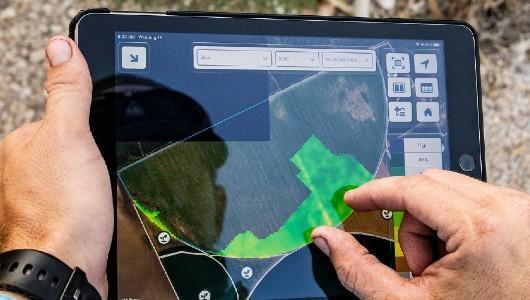
In this Ask the Expert, Gwen Uecker answers a few questions about USDA’s farmers.gov customer portal. Gwen serves as the Team Lead for the Program Delivery Division (PDD), Common Processes Branch for the Deputy Administrator of Farm Program within Farm Service Agency (FSA). She helps lead PDD’s effort to provide personalized customer information via farmers.gov.
A farmers.gov account provides self-service opportunities to FSA and Natural Resources Conservation Service (NRCS) customers via a secure authenticated access process.
What is the value of Customer Farm Records Mapping and why should producers use farmers.gov?
Customer Farm Records Mapping (cFRM) provides you with self-help options and access to FSA data from home 24/7. For example, you do not have to wait for FSA to mail out maps for acreage reporting or make a special trip to the office to pick up your maps. You can print farm tract maps directly from farmers.gov.
New features include the ability to import precision agriculture planting boundaries and create labels containing crop information that can be printed on-farm tract maps. The maps can then be provided to FSA at the local USDA Service Center for completing the annual crop acreage report. You can use the draw tools to determine acres in a drawn area. The drawn area can be printed on a map and provided to the Service Center, a third party such as a chemical applicator, or exported as a feature file for use in other geospatial applications.
In addition, you can “Switch Profile” to view cFRM data for individuals or entities you are authorized to act on behalf of. This means you can view and print maps for your entity’s farms. Producers can also view and print farm records details, including base and yield information (FSA-156EZ).
The FSA Farm Records Mapping page is accessed by clicking the blue “View Farm Records” button from the farmers.gov LAND tab.
To read the full blog visit Ask the Expert: Customer Farm Records Mapping Q&A with Gwen Uecker | Farmers.gov.
|
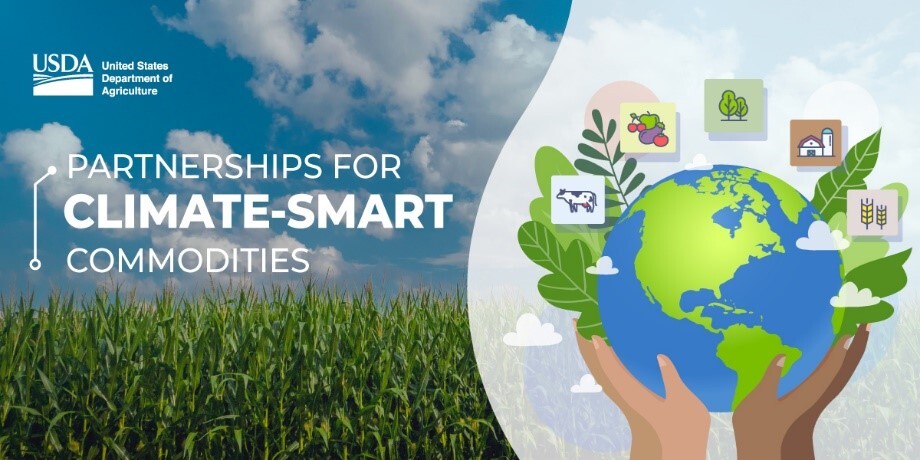 Partnerships for Climate-Smart Commodities
The U.S. Department of Agriculture (USDA) today announced the official kick-off of the implementation phase for projects funded through the $3.1 billion Partnerships for Climate-Smart Commodities effort. Project partners are beginning work on formal implementation of the climate-smart production practices, marketing, and quantification, monitoring, reporting and verification of greenhouse gas benefits that are funded through the effort as agreements are finalized on a rolling basis. As projects get underway, today USDA is launching the Partnerships for Climate-Smart Commodities Learning Network (Partnerships Network), a collaboration of all the project partners, which will generate key lessons-learned as projects are implemented. Learn More
Gardens are invited to join the 1,250 strong People’s Garden community.
The People’s Garden community is growing! Last May, USDA renewed the People’s Garden initiative. On the anniversary of the reopening we invite you to join approximately 1,200 People’s Gardens that have signed up nationwide in the past year by registering on the USDA People’s Garden website. Community gardens, urban farms, school gardens, and small-scale agriculture projects in rural, suburban and urban areas can join the “People’s Garden” community.
We invite you to:
-
Join the People’s Garden community.
-
Grow using sustainable practices that benefit people and wildlife.
-
Teach about local, resilient food systems.
People’s Gardens are marked on a map on the USDA website and may be featured in USDA communications. You’ll receive a People’s Garden sign to display and learn about People’s Garden community information such as webinars.
Sign up at www.usda.gov/peoples-garden
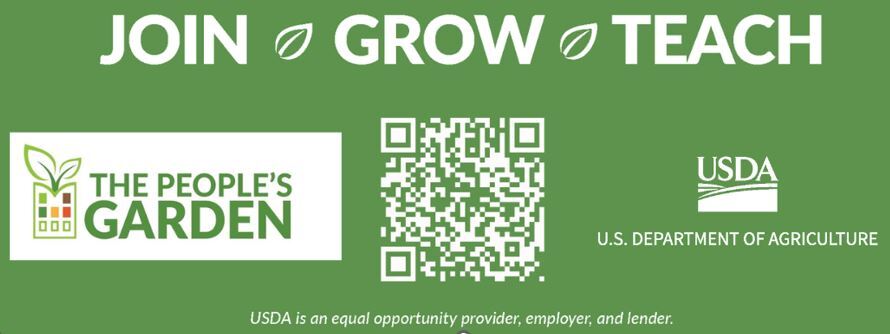 Register for Free National Gardening Webinars
The People’s Garden webinar series began in April. Future monthly topics include: Composting Awareness Month, Pollinator Month, Gardens Unifying Cultures and Commodities, Climate-Smart Agriculture and more. Webinars will be recorded and available for viewing on our website.
For registration information and to preview topics for upcoming monthly webinars, visit usda.gov/peoples-garden/webinars.

This six-week course is a discussion-based workshop bringing women together to learn from experts in production, financial management, human resources, marketing and the legal field.
There's plenty of time for questions, sharing, reacting, and connecting with your presenters and fellow participants. It's a relaxed, fun and dynamic way to learn, grow and meet other farm women.
Join Purdue University Extension for 3 weeks in June!
Tuesday Mornings from 9:00am – 12:00pm EST
Thursday Mornings from 9:00am – 12:00pm EST
Cost for the program is $65. Register by May 26th at https://bit.ly/2023anniesproject.
For more information contact Emily Kresca (eluc@purdue.edu) at 574-372-2340 or Jeff Pell (jpell@purdue.edu) 317-745-9260.
|
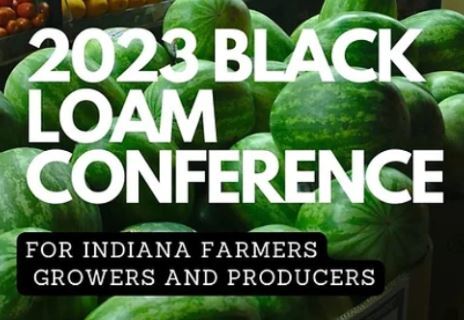
Legacy Taste of the Garden and Connecting Kids Inside Out are partnering with USDA’s Natural Resources Conservation Service (NRCS) in Indiana to host this year’s Indiana Black Farm Conference. The conference is part of a five-year cooperative agreement with NRCS to support and advance equity goals by providing critical outreach and technical assistance to Black, Indigenous and People of Color (BIPOC) farmers and producers throughout the State of Indiana.
Legacy Taste of the Garden hosted the first Black Loam Conference in 2022 and has hosted four events throughout Indiana in 2023. The fifth and final 2023 event will be May 20 in Indianapolis.
The event is free to attend, however seating is limited so pre-registration is required. The Black Loam Conference will provide information on USDA programs and resources available to BIPOC and socially disadvantaged producers in rural and urban communities.
You can register at www.legacytasteofthegarden.com/events.
|

The National AgrAbility Project is hosting a regional workshop June 6-8 in Indianapolis. This workshop will focus on U.S. military veterans in agriculture.
Workshop sessions include topics on business planning, getting your product to market, land access and estate planning, farming with a disability and resources, programs and benefits for veterans. The final day of the workshop will consist of tours of veteran-owned ag businesses.
For more information and to register for the workshop, visit AgrAbility.org.
|
USDA announced loan interest rates for May 2023, which were effective May 1, 2023. USDA’s FSA loans provide important access to capital to help agricultural producers start or expand their farming operation, purchase equipment and storage structures, or meet cash flow needs.
FSA also offers guaranteed loans through commercial lenders at rates set by those lenders.
Check your eligibility for FSA loans by utilizing the Farm Loan Assistance Tool. Find out which of these loans may be right for you by using our Farm Loan Discovery Tool.
Producers can explore available options on all FSA loan options at fsa.usda.gov or by contacting your local USDA Service Center.
2023 Indiana FSA Important Deadline Dates
May 26 – Final Day to Submit an Offer for the CRP Grasslands Program
May 29 – Offices Closed in Observance of Memorial Day
May 31– NAP Sales Closing Date for Nursery (Ornamental Nursery & Nonornamental Nursery) for June 1 – May 31 Crop Year
May 31– Final Date to Obtain Loans or Loan Deficiency Payments (LDP) on 2022 Harvested Feed Grains and Soybeans
June 1 – Date Used to Establish Ownership Interest for Person or Legal Entity for Program Purposes
June 1– Date Used for the Determination of Minor child for Program Purposes
June 2 – Final Date to Submit an Application for ERP Phase 2 and PARP
Ongoing - Signup for Continuous CRP
Ongoing – Submit an Application for a Farm Storage Facility Loan
Continuous - Submit an Application for FSA Farm Loans
Continuous - Signup for Local County Office FSA Text Alerts - Text Your Service Center Keyword to FSANOW (372-669)
Continuous – Sign up for GovDelivery Newsletters, Bulletins and Indiana Press Releases (Subscribe to USDA Emails for Farmers | Farmers.gov)
|